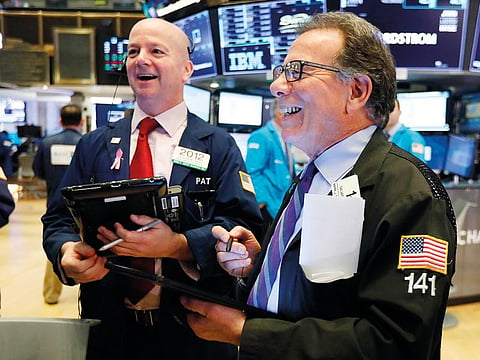Global stocks: 2020’s vaccine-driven rally boosts 2021 prospects
Equity markets worldwide have the potential to rise even further in the years to come

Dubai: Recent vaccine-related optimism will push markets to end 2020 strong, and analysts view further scope for stocks to rise in the years to come, even if it’s not as rapidly as it was in the past few months.
Despite warnings of steeper economic destruction, recession, job losses and business closures, most stock markets are likely to end the year on a positive note, buoyed mostly by central bank asset purchases, additional government debt and receding pandemic-related uncertainty.
“Good news about progress on coronavirus vaccines in the past month has started, or fuelled, a number of trends which we broadly expect to last through 2021, as those vaccines help the global economy reopen and policy mostly remains supportive,” noted John Higgins, chief markets economist at London-based research consultancy Capital Economics.
“The trends include a rise in breakeven inflation; a strong rally in risky assets generally; outperformance from the equity sectors, factors and regions that suffered most in the early stages of the pandemic; and a broad-based depreciation of the dollar,” Higgins added.
Scope to go even higher
With the US S&P500 benchmark breaching 3,700 points this week, up 14.5 per cent in the year to date, top analysts predict it could hit 4,000 points in less than two years. While Goldman Sachs is calling 4,300 points for the end of 2022, analysts at UBS are viewing the index to hit 4,400 points.
“We think there is scope for global equities to make more headway over the next couple of years, even if they don’t continue to rise as rapidly as they did last month,” Higgins opined.
In 2019, the S&P 500 stock market index soared 29 per cent, the second-highest gain in 21 years, the MSCI World Index was up around 24 per cent, France’s CAC40 was up 27 per cent, and the Shanghai Composite Index up 23 per cent. The stock markets in Britain and Hong Kong were up 12.7 per cent and 9 per cent respectively.
Coming on the heels of a record rally, the same indices saw steep losses at the start of 2020 – as markets crashed with uncertainty brought on by the COVID-19 health crisis. However stocks were rebounding in record time and staging a momentous rally – even as the pandemic still rages on.
Factors driving the rally
“Although this month’s gains in global equities can be largely attributed to the reaction to the US elections and encouraging news about potential vaccines against COVID-19, the rally since the spring has been underpinned more generally by extensive policy support,” said Higgins.
“With that in mind, we think that fiscal policy poses a bigger risk than monetary policy to a continuation of the rally in stock markets in coming years.”
Central banks and governments of most economies have been releasing a record-level of fiscal and monetary stimulus measures, with the US Federal Reserve, European Central Bank, Bank of Japan and most other countries cutting rates, buying assets (equities, debt) to support the financial markets, offering lines of credit and flooding the world with monetary liquidity.
With central banks and governments worldwide clear they will use all means to keep markets stable, with the flood of global liquidity and low-interest rates, analysts view that risk-appetite will remain fuelled and record-high retail investor participation in the markets will continue to be seen globally.
Risky assets to gain ground
“We continue to think that risky assets will gain more ground and that the US dollar will weaken against a backdrop of a recovering global economy and continued accommodative monetary policy,” Higgins noted.
“In our view, the outcome of the recent US elections and the news that a vaccine for COVID-19 may become available earlier and be more effective than previously anticipated has improved the distribution of potential outcomes for the economy and risky assets.”
While there is a disconnect between the economy and markets, it is widely seen as the difference between the current reality and expected future. If growth materializes as expected, analysts see the markets doing well and economies catching up. However, threat of a second or third COVID-19 wave in Europe and US and a move towards extended lockdowns can derail the nascent economic recovery.
“We still think that government bond yields will remain at very low levels,” Higgins cautioned. “The two key risks to this forecast are that the pandemic takes another turn for the worse over the winter and a vaccine still takes a long time to develop, produce, and distribute; and that policymakers withdraw support prematurely, undermining the economic recovery and the prospects for risky assets.”
Sign up for the Daily Briefing
Get the latest news and updates straight to your inbox






